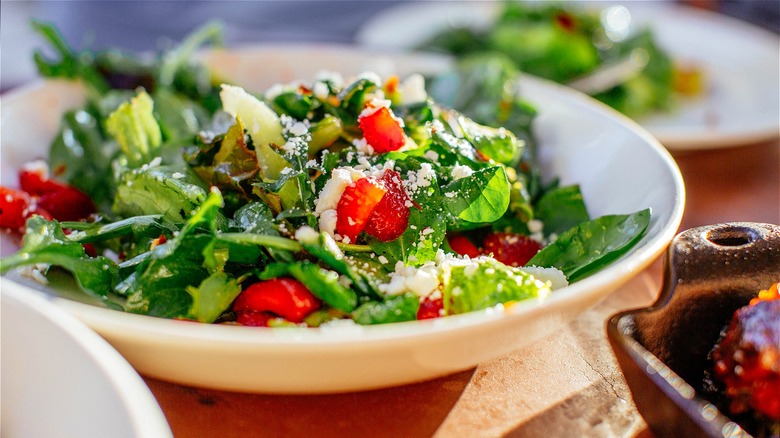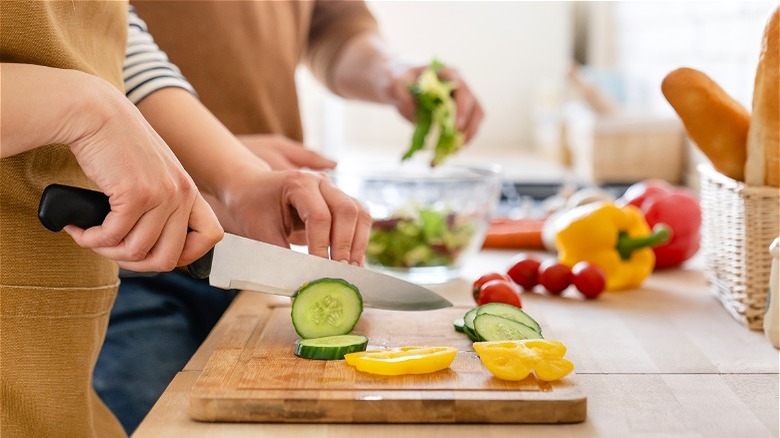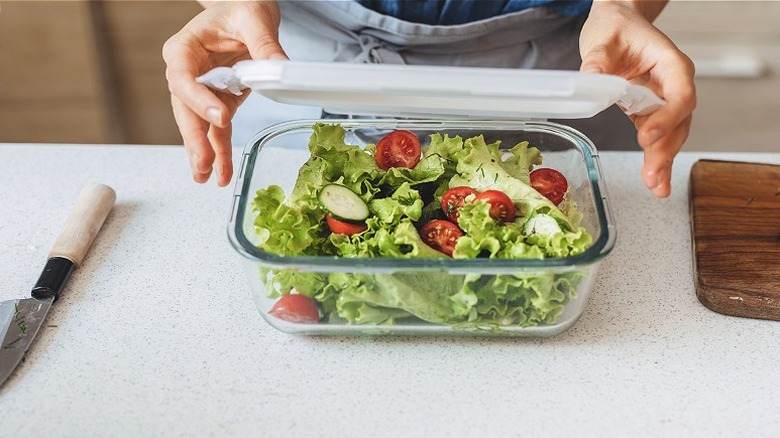The Key For A Crisp Chopped Salad Is All About The Timing
Some may argue that the most important factor when making some of the 50 best salad and salad dressing recipes is the produce you choose to prepare this fresh, colorful meal. Whether you're making a simple green salad, or transforming a classic bed of greens into a hearty dish by adding protein and crunchy toppings, a crucial component to a delicious salad is the fresh-tasting fruits and vegetables. Who enjoys salad only for the added seeds or bacon?
Making the ideal salad comes down to catering the ingredients to your own individual tastes, and the best part is, your options are endless. Once you've taken the time to choose your beloved toppings and chop all of your vegetables, you might discover that keeping your curated salad crisp before mealtime can be slightly challenging due to the multitude of fresh and cooked components pieced together.
In order to keep your next chopped salad fresh and crisp, keep your different ingredients in separate containers until right before it's time to eat. This way you don't run the risk of creating a mushy mess of a salad. When it's time to eat, simply assemble your salad and enjoy. Apart from using individual containers, what are some other time-sensitive ways to keep your plate of greens in tip-top shape before mealtime?
When it comes to crisp salad, timing is everything
Given the fact that salads are primarily composed of fresh produce, how and when you prepare nature's bounty is crucial since fruits and vegetables don't last forever. When choosing lettuce, you're better off choosing a firmer variety like romaine. While an intact head of lettuce can last up to three weeks, chopped romaine lasts up to 7 days in the refrigerator if kept dry with enough room to breathe.
If your overarching goal is to maintain that distinct crunchy bite, when prepping your salad, add heartier vegetables first and save the varieties that carry a lot of moisture until right before you eat. More or less, for the best chopped salad, mind the wet ingredients. Fresh vegetables like cucumbers and tomatoes are primarily composed of water, so add this chopped assortment closer to mealtime, or choose an intact variety of tomatoes like cherry or grape. This way the extra water leaching out from your vegetables won't wilt your salad greens.
When it comes to adding precooked proteins and toppings like roasted nuts or cheese, be mindful that you're not packing too many heavy ingredients on top of delicate greens. This way the lettuce leaves don't lose their shape or crunchy texture. Now that you know to remain aware of the moisture content of your produce and topping choices, what else is important to keep in mind if you're wanting a firm and crisp salad each and every time?
Salad dressing timeliness and proper storage
Among the 20 mistakes you need to avoid when making a salad, keeping your lettuce nice and dry is of top importance, so adding your favorite dressing too early could potentially leave you with soggy results. If you're taking a tray of salad to a get-together, bring a separate container for your dressing and add this flavorful component to your greens just before serving. Alternatively, you can assemble an upside-down salad. Simply add dressing to the bottom of a sealable container, add your protein and toppings of choice, vibrant produce, and then finally lettuce: the main ingredient most affected by moisture. This way when you're ready to serve your salad, all you need to do is mix up the ingredients from the base of your container.
When it comes to storing your freshly curated salad, glass is preferred over plastic. Glass containers that have a tight-fitting lid are more effective at keeping outside odors, moisture, and oxygen from your salad greens which can ultimately affect the taste and texture of your meal. As long as you take the time to keep your salad greens dry before assembling and waiting to add those moisture-rich ingredients right before serving, you should always be able to sit down to a fresh, crisp plate of salad anytime.


